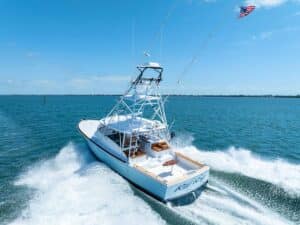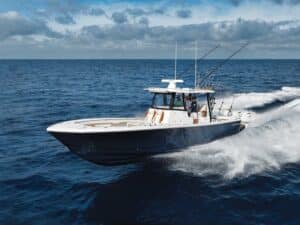
Long-Range Fuel Bladders
Over the last 35 years, we have done many high-mileage open-ocean transits. In the early days, the boats were 30 to 45 feet with limited fuel. Now, with the big sport-fishing boats being 60, 70 and 80 feet with thousands of gallons of fuel, we still need more capacity, because we are going farther. We’ve made some neat open-ocean transits, such as Portimão, Portugal, to Madeira; the mainland United States to Bermuda; and Colón, Panama, straight to the Yucatan, to name a few.
We just completed a several-month journey through the Bahamas to Jamaica, then through the Panama Canal to the Pacific, where, unfortunately, we encountered cold, green water and poor billfishing.
After two months of fishing and hoping for a change, we pulled the plug on the cold, green water, as it never rolled over, and we came back through the canal and traveled on up to one of our favorite fishing places — Isla Mujeres on the Yucatan Peninsula — where we enjoyed fantastic fishing during the month of May. It was more than 2,500 miles of steaming there and back, not including our fishing time, on four fuel fills, so we played the fuel game every bit of the way.
To make such high-mileage trips, weather and fuel planning are constant topics before and during the trip. Plotting out the fuel stops, measuring fuel mileage and trying to get the best mileage you can, especially when fuel is over $4 per gallon and, in some places, over $6 per gallon, you are constantly trying to make the best of an expensive situation.
Knowing where to plan stops for better fuel prices is as easy as picking up the phone, but those stops are also highly dependent on the weather, quite often few and far between, or just not available. Being able to run at speed before bad weather closes in because you have more than enough fuel helps keep your traveling time in rough seas to a minimum, making it easier on both you and your boat.
When the weather is nice, it also helps to have the time to chug at a 10- to 12-knot travel speed, stretching your fuel and taking it easy on the boat. At the chug speed, you can have several days and nights steaming where you can work on the boat and tackle, cook hot meals and enjoy life at sea — all while maximizing your fuel mileage. Many folks focus on engine hours and feel that chugging is counterproductive, because it puts so much time on the engines, but this is mainly driven by the misconception that high hours on engines is a bad thing — a claim mostly made by brokers.
Actually, the duty cycle of these recreational engines on sport-fishing boats is generally quite light compared to, say, commercial applications in the fishing or offshore oil industry. The more realistic measurement of wear and tear on engines is how much fuel has been run through them, which is how most commercial application users define age. The harder, or faster, you run, the more fuel gets run through the engines.
Getting to your destination within a particular weather window always makes for better traveling, and having the fuel to get where you are going with the fewest possible stops helps reduce the exposure to weather. Using fuel bladders or on-deck tanks helps to increase fuel capacity and also gives you an opportunity to purchase bulk fuel at a discounted price. No matter who you are, fuel savings are always welcome. I know that the more I save getting to and from a destination, the more I have to fish with while I’m there.
We have used several different types of on-deck fuel systems. Back in the day, the plastic 55-gallon drums did the job, and a couple of boats even had custom-made aluminum tanks that fit in the cockpit. The on-deck plastic Chem-Tainer tanks have worked well; however, bladder-style systems seem to be the systems of choice for a lot of world travelers. Recently, the technology built into the bladder-style fuel cells has made these very practical and desirable. They are easy to use and incredibly easy to stow after use.
The hard on-deck tanks, either plastic or metal, work well; however, they require a bit more work and storage space once you get to your destination. They are not practical for carrying spare fuel to get you to the fishing grounds for a far offshore run, like to the canyons or out in the Gulf of Mexico — a couple of hundred miles for multiday trips. Since you are stuck with storing them in the cockpit, they are strictly an A-to-B destination setup.
For our plastic tanks, which are 225 gallons each, we make aluminum footprint frames with welded brackets, so we can fasten them to the boat to keep them from sliding around when steaming. We fasten removable eye bolts along the toe-kick under the gunwale and then use load-rated ratchet motorcycle tie-downs to crisscross a web fore and aft to keep the tanks from sliding. We also use large ratchet tie-downs, like those that are used to secure loads on flatbed trucks, to secure the tanks down on the footprint brackets.
To move the fuel, we have a portable 24-volt fuel pump with quick disconnects on the tanks (and on the bulkhead tank fittings) in the engine room. By installing the quick disconnects on our tank “clean out” fitting on the front of the tank, we do not have to worry about transferring at the on-deck gunwale fuel fill, so spray or rain is not an issue for us; we can transfer and keep steaming. It is also safer, since no one needs to hang over the side of the boat to reach a fill.
Not all boats come equipped with a clean-out fitting, nor are they all accessible from the front of the tank; however, if you can manage this little trick, it’s the best way to go. Fittings on top of the tanks tend to create problems, and they are hard to access for repair; you generally have to cut the deck to get to them. This is not the case when the builder puts all the fuel-tank fittings on the front of the tank, where they are easily accessible for servicing.
Without a doubt, the best option for a traveling sport-fisherman is the bladder-style tanks. The flexibility of the bladder-style tanks for capacity and ease of storage makes them useful for either A-to-B destination transits or far offshore fishing trips. We have a custom-made ATL (Aero Tec Laboratories, atlinc.com) fuel locker bladder that fits between the inboard stringers in our engine room, and I use it regularly, especially when traveling to the Bahamas. I can buy fuel at a much better price at home, so every bit that I can carry makes me less dependent on expensive fuel.
ATL manufactures two different styles of fuel cells from a military-specialized-grade rubber material that is safe for gas or diesel. The fuel locker, like the one we have, is a space-saving mattress-style bladder that uses roughly half the deck space as the Petroflex pillow-style bladder. However, both styles have their advantages. Some applications need a lower-profile Petroflex, while others, like my boat, with its engine-room-stringer application, need to use the elevation of the fuel locker to get the capacity.
The Petroflex and the ATL fuel locker can both be used on deck or in a vented locker, so you have a great deal of flexibility in choosing which best suits your needs. ATL makes standard stock sizes in various gallon capacities for both styles; however, ATL can make what you need to fit a specific space or capacity requirement. Simply make a sketch with your dimension requirements and send it along to them, and you are off and running.
ATL supplies fuel cells to multiple Nascar teams and is the sole supplier of non-explosive cells to Formula 1 Series. ATL also manufactures cells as large as 50,000 gallons for the military. These folks have a great product with quality components and top-notch service.
The advantages that extra fuel gives you when making long trips, or just increasing your safe fuel range for offshore trips to reach out and fish fresh grounds, is immeasurable. If you’ve ever been on the margin or run out of fuel because you pushed your limits, you need to look into having a fuel bladder. It might just be the thing that sparks your travel bug or puts you on the bite someplace you couldn’t reach before.







